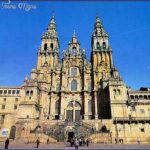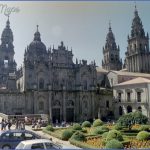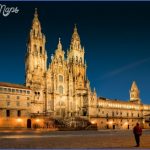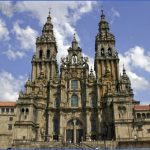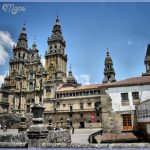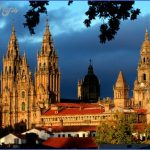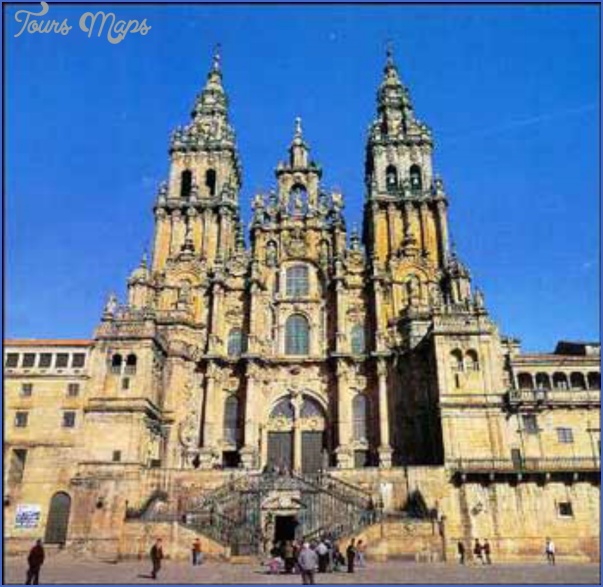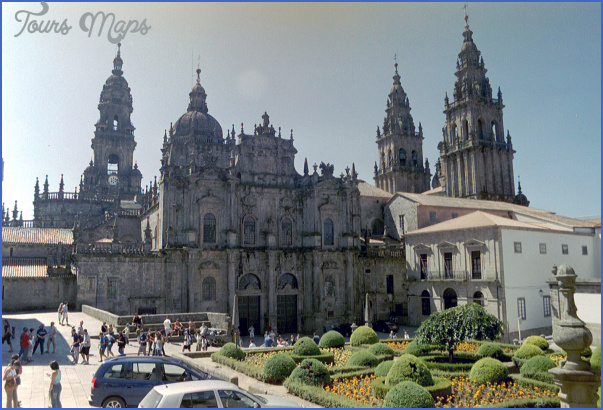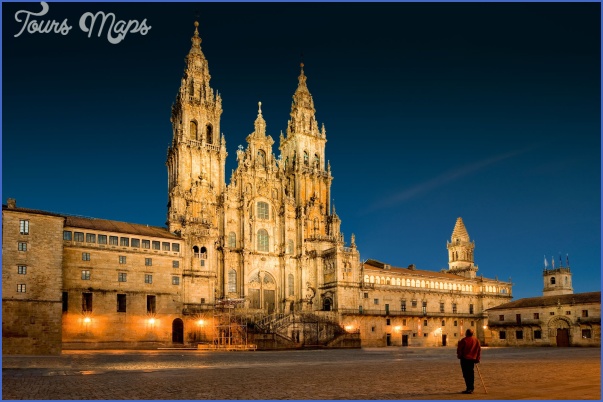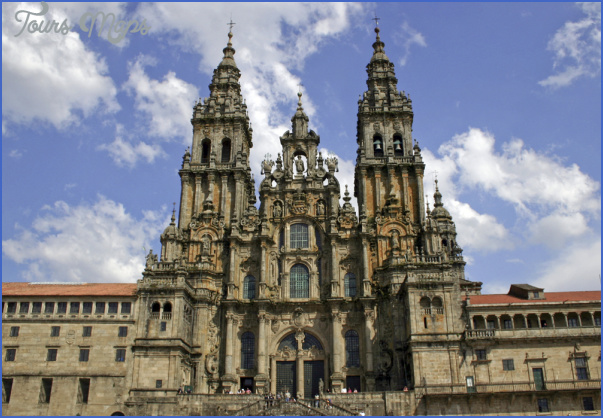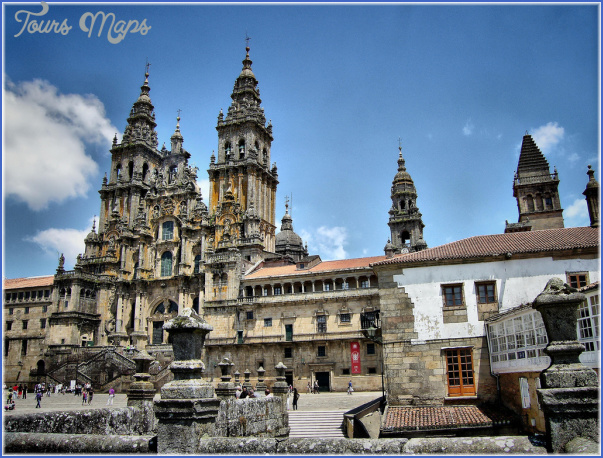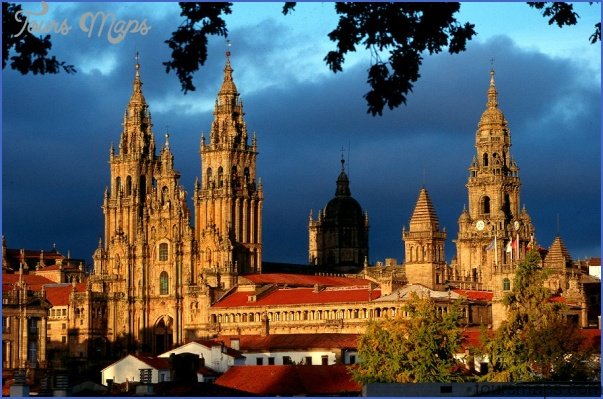SANTIAGO DE COMPOSTELA
Santiago (pop. 140,000) has long drawn pilgrims eager to gaze at one of Christianity’s holiest cities. The cathedral marks the end of the Camino de Santiago, a pilgrimage believed to halve one’s time in purgatory. Today, sunburnt pilgrims, street musicians, and hordes of tourists fill the streets.
TRANSPORTATION AND PRACTICAL INFORMATION. Trains (981 52 02 02) run from R. Horreo to Madrid (8hr.; M-F 1:45 and 10:25pm, Sa 10:30pm, Su 9:45am, 1:45, and 10:30pm; ‚36). A schedule is printed daily in El Correo Gallego. To reach the city, take bus #6 to Pr. Galicia or walk up the stairs across the parking lot from the main entrance, cross the street, and bear right onto R. Horreo, which leads to Pr. Galicia. Buses (981 58 77 00) run from R. de Rodriguez (20min. from downtown) to: Bilbao (ll’ihr. 9am and 9:30pm, ‚39); Madrid (8-9hr. 4 per day, ‚31); and San Sebastian (13y2hr. 8am and 5:30pm, ‚44). From the station, take bus #10 to Pr. Galicia. The tourist office is at R. do Vilar 43. ( 981 58 40 81. Open M-F 10am-2pm and 4-7pm, Sa llam-2pm and 5-7pm, Su llam-2pm.) Check email at CyberNova 50, R. Nova 50. (9am-10pm ‚1.20 per hr. lOpm-lam ‚1 per hr. Open daily 9am-lam.) Postal Code: 15701.
ACCOMMODATIONS AND FOOD. Nearly every street in the ciudad vieja houses at least one or two pensiones. Rua Vilar and Rua da Raina are the liveliest and most popular streets. liHospedaje Ramos O, R. da Raina 18, 2nd fl. above 0 Papa Una restaurant, is in the center of the ciudad vieja. (981 58 18 59. Singles ‚14; doubles ‚25.) Hospedaje Santa Cruz , R. Vilar 42, 2nd fl. is close to a myriad of bars and restaurants. ( 981 58 28 15. Singles ‚15; doubles ‚25, with bath ‚40.) Renovated in 2003, Hostal Barbantes , Pr. de Fonseca 5, lets big rooms, each with bath. (981 57 65 20. Singles ‚40; doubles ‚60.) Hos-pedaja Fonseca , R. de Fonseca 1, 2nd fl. offers colorful, sunny rooms with kitchen, TV, and winter heating. ( 981 57 24 79. Singles ‚12-15; doubles ‚24-30; triples ‚36-45; quads ‚48-60.) Take bus #6 or 9 to get to Camping As Cancelas , R. 25 de Xullo 35, 2km from the cathedral on the northern edge of town. (981 58 02 66. ‚4.40 per person, ‚4.70 per car or per tent.) Bars and cafeterias line the streets, offering a variety of inexpensive menus; most restaurants are on R. do Vilar, R. do Franco, R. Nova, and R. da Raina. Santiago’s market, between PI. San Felix and Convento de San Augustin, is a sight of its own right. (Open M-Sa 7:30am-2pm.) Supermercado Lorenzo Froiz, PI. do Toural, is one block from Pr. de Galicia. (Open M-Sa 9am-3pm and 4:30-9pm, Sa 9am-3pm and 5-9pm.)
HOLD YOUR HORSES
Over 100,000 wild horses inhabit the Galician hills, where they have roamed for nearly 4000 years. Once used as cart-pullers, few are domesticated today. Still, the age-old branding rituals are celebrated each July during A Rapa das, Bestas (The Shearing of the Beasts).
“Here, we fight horses for tradition, says one rider, a sweaty, blood-speckled bandana across his hairline. The blood may not be his; for the past two hours he’s straddled, head-locked, tail-pulled, herd-surfed, tackled, branded, been kicked and bitten, and-most importantly-sheared numerous feisty steeds. The struggle between man and beast is central to Spanish culture, most famously (and controversially) played out between matador and bull. A Rapa gives a new face to the traditional dynamic.
Before the festivities begin, Galician men comb the mountains and valleys gathering wild horses. Then, brave souls, wielding scissors, fight their way into the writhing sea of animals, wrestle one horse at a time to submission, and send thick crops of shiny hair flying to the ground-to be collected later by children as souvenirs.
SIGHTS AND NIGHTLIFE. Santiago’ s cathedral has four facades, each a masterpiece from a different era, with entrances opening to four different plazas: Praterias, Quintana, Obradoiro, and Inmaculada. The southern Praza das Praterias is the oldest of the facades; the Baroque Obradoiro encases the Maestro Mateo’s Portico de la Gloria, considered the crowning achievement of Spanish Romanesque sculpture. The remains of St. James (Santiago) lie beneath the high altar in a silver coffer. Inside the museum are gorgeous 16th-century tapestries and two poignant statues of the pregnant Virgin Mary. (Cathedral open daily 7am-7pm. Museum open June-Sept. M-Sa 10am-l:30pm and 4-7:30pm, Su 10am-l:30pm; Mar.-June M-Sa 10:30am-l:30pm and 4-6:30pm, Su 10:30am-l:30pm; Oct.-Feb. M-Sa 11am-lpm and 4-6pm, Su llam-lpm. Museum and cloisters ‚5, students ‚3.) Those curious about the Camino de Santiago can head to the iilMuseo das Peregrinations, PI. de San Miguel Dos Agros. (Open Su 10:30am-l:30pm, Tu-F 10am-8pm, Sa 10:30am-l:30pm and 5-8pm. In most of summer free. Off-season ‚2.40.)
At night, crowds looking for post-pilgrimage consumption flood cellars throughout the city. Take R. Montero Rios to the bars and clubs off Praza Roxa to party with local students. UCasa oas Crechas, Via Sacra 3, just off Pr. da Quintana, is a smoky pub with a witchcraft theme. (Beer ‚2. Open daily 4pm-2am or later.) Xavestre, R. de San Paolo de Antaltares 31, is packed with 20-somethings. (Mixed drinks ‚5. Open daily 1 lam-late.) Students dance the night away at La Quintana Cafe, Pr. da Quintana 1. (Beer ‚3-5. Mixed drinks ‚4. Open daily lOam-late.)
DAYTRIP FROM SANTIAGO; CASTRO DE BARONA.
South of the town of Noia is a little-known treasure of historical intrigue and mesmerizing natural beauty: The seaside remains of the 5th-century Celtic fortress of 110 Castro de Baroiia. Its foundations dot the isthmus, ascending to a rocky promontory above the sea and then descending to a crescent beach, where clothing is optional. Castromil buses from Santiago to Muros stop in Noia (lhr.; M-F 15 per day, Sa 12 per day, Su 8 per day; ‚3) and Hefsel buses from Noia to Riveira stop at O Castro tell the driver your destination (30min.; M-F
14 per day, Sa 7 per day, Su 11 per day; ‚1.30).
ASTURIAS
Spaniards call the tiny land of Asturias a paraiso natural (natural paradise). Surrounded by centuries of civilization, its impenetrable peaks and dense alpine forests have remained untouched. Unlike the rest of the country, travelers don’t come here to see the sights; they come here to brave them.
PICOS DE EUROPA
This mountain range is home to Picos de Europa National Park, the largest national park in Europe. The most popular trails and peaks lie near the Cares Gorge (Garganta del Cares). For a list of mountain refugios (cabins with bunks but no blankets) and general park info, contact the Picos de Europa National Park Visitors’ Center in Cangas de Oni’s. (mfax 985 84 86 14. Open May-Sept. M-F 9am-2pm and 5-6:30pm, Sa 9am-2pm and 4-6:30pm, Su 9am-2:30pm; Oct.-Apr. M-Sa 9am-2pm and 4-6:30pm, Su 9am-2:30pm.)
CANGAS DE ONIS. During the summer months the streets of Cangas (pop. 6,285) are packed with mountaineers and vacationing families looking to spe-lunk and hang glide in the Picos de Europa National Park. Cangas itself is, if not particularly thrilling, a relaxing town rich in history. The tourist office, Jar-dines del Ayuntamiento 2, is just off Av. de Covadonga, across from the bus stop, (a 985 84 80 05. Open May-Sept. daily lOam-lOpm; Oct.-Apr. 10am-2pm and 4-7pm.) ALSA, Av. de Covadonga 18 (985 84 81 33), in the Pi’caro Inmobil-iario building across from the tourist office, runs buses to Madrid (7hr. 2:35pm, ‚26) via Valladolid (5hr. 2 per day, ‚145).
SANTIAGO DE COMPOSTELA Photo Gallery
Maybe You Like Them Too
- Explore the Beautiful Town of Saint-Alban, France with This Map
- Explore the Beautiful City of Southport, Australia with This Map
- Explore Sasbach, Germany with our Interactive Map
- Explore Nevestino, Bulgaria with this Detailed Map
- Explore Pulau Sebang Malaysia with this Detailed Map

